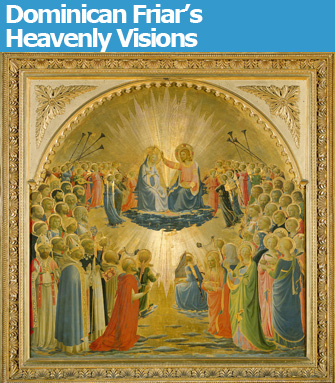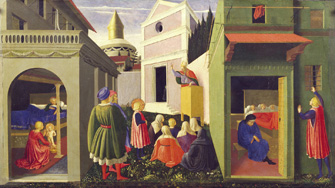 |
|
Fra Angelico’s “The Coronation of the Virgin” (1434-1435). Uffizi Gallery © 2010. Photo Scala, Florence courtesy of the Ministero Beni e Att. Culturali |
For sheer visions of loveliness in heavenly, harmonious colors, the paintings of Fra Angelico (1387-1455) reign supreme. The current show at the Musée …
 |
|
Fra Angelico’s “The Coronation of the Virgin” (1434-1435). Uffizi Gallery © 2010. Photo Scala, Florence courtesy of the Ministero Beni e Att. Culturali |
For sheer visions of loveliness in heavenly, harmonious colors, the paintings of Fra Angelico (1387-1455) reign supreme. The current show at the Musée Jacquemart-André, “Fra Angelico and the Masters of Light,” does full justice to the great master with 30 beautiful works, set in the context of work by some of his contemporaries.
Fra Angelico (born Guido di Pietro), a Dominican friar, was caught up in Florence’s flourishing Renaissance and proved himself adept at combining International Gothic pictorial traditions (e.g., storytelling and an emphasis on the mystical qualities of light) with such Renaissance innovations as the use of perspective and more realistic depictions of human figures.
The show begins with a couple of paintings and miniatures by his master, Lorenzo Monaco and with two of Fra Angelico’s undated paintings of the Thebaid (a desert in Egypt that was home to many Christian hermits), which, although they have a primitive look about them, show off his talent in the stupefying amount of detail included; they positively swarm with little scenes of quiet life and dramatic incident in the lives of the hermits. The first room also boasts a perfect jewel of a miniature by Brother Angelico depicting an elegantly dressed madman holding a spear.
While all of the friar’s paintings in this show are beautiful or at least interesting, a few stand out from the rest. Look at “The Martyrdom of Saints Cosmas and Damian,” for example. The goriness of the beheading scene, with three men who have just lost their heads and two more on deck for execution on the right, is tempered by the naturalism of the poses of the onlookers on the left and contrasts with the peaceful, stylized landscape behind. In an early nativity scene, the infant Jesus on his bed of hay is himself the source of light illuminating the kneeling worshipers around him – his mother, his father and an ox – while miniature blue angels perch on the roof of the shed.
To place Fra Angelico in the context of the times, the show offers works by pioneers in the use of perspective who came before him, Masaccio, Paolo Uccello and Filippo Lippi. A few of Fra Angelico’s followers, notably Zanobi Strozzi, are also represented to show how they
 |
|
“Episodes from the Life of St Nicholas: Birth, Vocation and Gift to Three Poor Young Girls” (c. 1437). Vatican Museums, Vatican City © 2011. Photo Scala, Florence |
interpreted the lessons they learned from the master. They sometimes also serve to demonstrate the superiority of Fra Angelico: in Alesso Baldovinetti’s painting of the Virgin and child surrounded by a number of saints, for example, the baby Jesus looks like a stiff doll lying uncomfortably in his mother’s lap, although other aspects of the work are highly skillful, notably the sumptuous draperies.
Giorgio Vasari, painter and author of Lives of the Artists, claimed that Fra Angelico was so devout that tears streamed down his cheeks every time he painted a crucifixion scene, and even an irreligious viewer cannot help but be moved by the quiet acceptance on the face of Christ in the “Arma Christi” painted on parchment, perhaps a study for the fresco in cell 26 of the San Marco convent, one of the great treasures of Florence, where Fra Angelico not only painted the Annunciation scene he is perhaps best known for, but also decorated each of the cells with scenes from the life of Christ. It’s a place that anyone interested in Italian painting must visit, as is this exhibition.
After showing several elegant and lovely paintings of the Virgin and child, the exhibition ends with the “Armadio degli Argenti,” the magnificent decoration for the doors of a silver treasury, a work that shows off Fra Angelico’s great talent for pictorial narration in panels based on St. Thomas Aquinus’s Lex Amoris, linking the stories of the Old and New Testaments.
Musée Jacquemart-André: 158, boulevard Haussmann, 75008 Paris. Métro: Saint-Augustin, Miromesnil or Saint-Philippe du Roule. RER: Charles de Gaulle-Étoile. Tel.: 01 45 62 11 59. Open daily, 10 a.m.-6 p.m. (until 9:30pm on Monday and Saturday). Admission: €10. Through January 16, 2012. www.musee-jacquemart-andre.com
Order books on Fra Angelico from Paris Update’s Amazon store at no extra cost. Click on your preferred Amazon location: France, U.S.
Reader Reaction: Click here to respond to this article (your response may be published on this page and is subject to editing).
More reviews of Paris art shows.
© 2011 Paris Update
Favorite